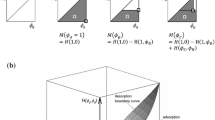Summary
A model of isothermal moisture movement in wood during drying using the gradient in water potential as the driving force is proposed. The moisture transport coefficient used in this model is the effective water conductivity. It is a function of moisture content, temperature, and direction of flow. The boundary desorption curve of the effective water conductivity function is established in the radial and tangential directions of aspen sapwood from nearly saturated to dry conditions at 20, 35, and 50 °C using the instantaneous profile method. The results show that the effective water conductivity increases exponentially with moisture content and temperature. The effect of temperature cannot be solely explained by the variation of the viscosity of water. The variation of the moisture content-water potential relationship with temperature would explain a large part of this effect. The effective water conductivity was generally higher in the radial direction than in the tangential direction in a ratio varying from 1/1 to 25/1 depending on moisture content and temperature. The flux-gradient relationship obtained at given moisture contents were found to be linear, confirming the validity of the model for the experimental conditions considered in the present work.
Similar content being viewed by others
References
Bear, J.; Braester, C.; Menier, P. C. 1987: Effective and relative permeabilities of anisotropic porous media. Transport in Porous Media 2: 301–316.
Ben Nasrallah, S.; Perre, P. 1988: Detailed study of a model of heat and mass transfer during convective drying of porous media. Int. J. Heat Mass Transfer 31: 957–967.
Choong, E. T. 1965: Diffusion coefficients of softwoods by steady-state and theoretical methods. Forest Prod. J. 15: 21–27.
Cloutier, A.; Fortin, Y. 1991: Moisture content — water potential relationship of wood from saturated to dry conditions. Wood Sci. Technol. 25: 263–280.
Comstock, G. L. 1963: Moisture diffusion coefficients in wood as calculated from adsorption, desorption and steady state data. Forest Prod. J. 13: 97–103.
Edlefsen, N. E.; Anderson, A. B. C. 1943: Thermodynamics of soil moisture. Hilgardia 15: 31–298.
Felixx, S.; Razafinddrakoto, J. C.; Castera, P. 1989: Modeling of hygrothermoelastic effects during timber drying. In: Kayihan, F.; Johnson J. A.; Smith, W. R.; (Eds.): Proceedings of the IUFRO International Wood Drying Symposium, pp. 238–246. Seattle, USA.
Flühler, H.; Ardakani, M. S.; Stolzy, L. H. 1976: Error propagation in determining hydraulic conductivities from successive water content and pressure head profiles. Soil Sci. Soc. Am. J. 40: 830–836.
Fortin, Y. 1979: Moisture content — matric potential relationship and water flow properties of wood at high moisture contents. Ph.D. dissertation, Dept. of Forestry, The University of British Columbia, Vancouver, Canada.
Haridasan, M.; Jensen, R. D. 1972: Effect of temperature on pressure head — water content relationship and conductivity of two soils. Soil Sci. Soc. Amer. Proc. 36: 703–708.
Hartley, J. G. 1986: Coupled heat and moisture transfer in soils: a review. In: Mujumdar, A. S., (Eds.): Advances in Drying. Vol. 4, pp. 199–248. New York: Hemisphere Publishing Corp.
Hillel, D. 1971: Soil and water. Physical principles and processes. New York, London: Academic Press.
Irudayaraj, J.; Haghighi, K.; Stroshine, R. L. 1990: Nonlinear finite element analysis of coupled heat and mass transfer problems with an application to timber drying. Drying Technology 8: 731–749.
Kawai, S.; Nakato, K.; Sadoh, T. 1978: Moisture movement in wood below the fiber saturation point. Mokuzai Gakkaishi 24: 273–280.
Luikov, A. V. 1966: Heat and mass transfer in capillary-porous bodies. Oxford, London, Edinburgh, New York, Paris, Frankfurt: Pergamon Press.
Martin, R. E.; Moschler, W. W. Jr. 1970: Measurement of diffusion coefficients in wood by the Matano solution. Wood Sci. 2: 186–192.
Palin, M. A.; Petty, J. A. 1983: Permeability to water of the wood cell wall and its variation with temperature. Wood Sci. Technol. 17: 187–193.
Perre, P.; Maillet, D. 1989: Drying of softwoods: the interest of a two-dimensional model to simulate anisotropy or to predict degrade. In: Kayihan, F.; Johnson, J. A.; Smith, W. R.; (Eds.): Proceedings of the IUFRO International Wood Drying Symposium, pp. 226–237. Seattle, USA.
Philip, J. R. 1969: Theory of infiltration. Adv. Hydrosci. 5: 215–296.
Plumb, O. A.; Spolek, G. A.; Olmstead, B. A. 1985: Heat and mass transfer in wood during drying., Int. J. Heat Mass Transfer 28: 1669–1678.
Siau, J. F. 1984: Transport processes in wood. Berlin Heidelberg New York: Springer.
Siau, J. F.; Bao, F.; Avramidis, S. 1986: Experiments in nonisothermal diffusion of moisture in wood. Wood Fiber Sci. 18: 84–89.
Skaar, C.; Siau, J. F. 1981: Thermal diffusion of bound water in wood. Wood Sci. Technol. 15: 105–112.
Stamm, A. J. 1959: Bound water diffusion into wood in the fiber direction. Forest Prod. J. 9: 27–31.
Stanish, M. A. 1986: The roles of bound water chemical potential and gas phase diffusion in moisture transport through wood. Wood Sci. Technol. 20: 53–70.
Stanish, M. A.; Schajer, G. S.; Kayihan, F 1986: A mathematical model of drying for hygroscopic porous media. AIChE J. 32: 1301–1311.
Thomas, H. R.; Lewis, R. W.; Morgan, K. 1980: An application of the finite element method to the drying of timber. Wood Fiber 11: 237–243.
Weast, R. C., (Ed.) 1989: Handbook of chemistry and physics. 70st ed. Cleveland, Ohio, USA: CRC Press Inc.
Whitaker, S. 1977: Simultaneous heat, mass, and momentum transfer in porous media: a theory of drying. In: Advances in heat transfer. Vol. 13, pp. 119–203. New York: Academic Press.
Author information
Authors and Affiliations
Additional information
The authors wish to thank Peter Garrahan of Forintek Canada Corp., Ottawa for his comments and suggestions. This research was undertaken while the senior author was a grant-holder from the Fonds pour la Formation de Chercheurs et l'Aide à la Recherche, Gouvernement du Québec
Rights and permissions
About this article
Cite this article
Cloutier, A., Fortin, Y. A model of moisture movement in wood based on water potential and the determination of the effective water conductivity. Wood Sci.Technol. 27, 95–114 (1993). https://doi.org/10.1007/BF00206228
Received:
Issue Date:
DOI: https://doi.org/10.1007/BF00206228




